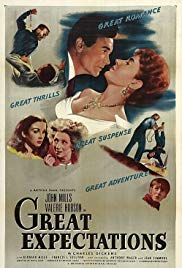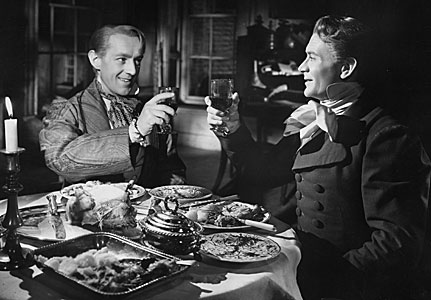GREAT EXPECTATIONS
SUBJECTS — World/England; Literature/England;
SOCIAL-EMOTIONAL LEARNING — Romantic Relationships;
MORAL-ETHICAL EMPHASIS — Trustworthiness.
AGE: 10+; No MPAA Rating;
Drama; 1946; 118 minutes; B & W. Available from Amazon.com.
There is NO AI content on this website. All content on TeachWithMovies.org has been written by human beings.

SUBJECTS — World/England; Literature/England;
SOCIAL-EMOTIONAL LEARNING — Romantic Relationships;
MORAL-ETHICAL EMPHASIS — Trustworthiness.
AGE: 10+; No MPAA Rating;
Drama; 1946; 118 minutes; B & W. Available from Amazon.com.
This is a film version of Dickens’ classic novel.
Selected Awards: 1947 Academy Awards: Best Art Direction/Set Decoration (B & W), Best Black and White Cinematography; 1947 National Board of Review Awards: Ten Best Films of the Year; 1947 Academy Award Nominations: Best Picture, Best Director (Lean), Best Screenplay.
Featured Actors: John Mills, Valerie Hobson, Anthony Wager, Alec Guinness, Finlay Currie, Jean Simmons, Bernard Miles, Francis L. Sullivan, Martita Hunt, Ivor Barnard, Freda Jackson.
Director: David Lean.
Great Expectations develops a number of themes which are especially appropriate for young adolescents, including relationships between boys and girls and the fear of the stranger who comes in the night. The film also shows the harshness of English society in the 18th and early 19th centuries, the beginning of the Industrial Revolution.
Charles Dickens’ classic novel, from which this film has been adapted, is often assigned reading in both English and History classes. Try to see that the film is viewed only after the book has been read. The information in the Helpful Background section may offer assistance to your child in his or her study of the book.

The ending of the movie was changed from the book. In the original ending, Pip describes the last time he saw Estella.
It was two years more before I saw herself. I had heard of her as leading a most unhappy life, and as being separated from her husband, who had used her with great cruelty, and who had become quite renowned as a compound of pride, brutality, and meanness. I had heard of the death of her husband (from an accident consequent on ill-treating a horse), and of her being married again to a Shropshire doctor, who against his interest, had once very manfully interposed on an occasion when he was in professional attendance on Mr. Drummle and had witnessed some outrageous treatment of her. I had heard that the Shropshire doctor was not rich and that they lived on her own personal fortune. I was in England again – in London, and walking along Piccadilly with little Pip – when a servant came running after me to ask would I step back to a lady in a carriage who wished to speak to me. It was a little pony carriage which the lady was driving, and the lady and I looked sadly enough on one another. ‘I am greatly changed, I know, but I thought you would like to shake hands with Estella too, Pip. Lift up that pretty child and let me kiss it!’ (She supposed the child, I think, to be my child.) I was very glad afterward to have had the interview; for in her face, and in her voice, and in her touch, she gave me the assurance that her suffering had been stronger than Miss Havisham’s teaching, and had given her a heart to understand what my heart used to be.
This ending validates the teachings of the earlier part of the novel. Estella was a symbol of false values which had caused Pip pain and difficulties and which he had learned, in his maturity, to eschew. Permitting Pip to have his cake and eat it too by marrying Estella undercuts these lessons.
What should Pip have done when he first met Ms. Havisham and Estella?
Suggested Response:
He should have turned around and walked out. But he was not capable of this at the time.
1. See Discussion Questions for Use With any Film that is a Work of Fiction.
2. Gargery is sometimes shown to be a fool or a nurturing wonderful man of great dignity. Why is this?
3. What values did Estella stand for?
4. What values did the benefactor stand for?
5. Which ending do you prefer? Explain why.
Discussion Questions Relating to Ethical Issues will facilitate the use of this film to teach ethical principles and critical viewing. Additional questions are set out below.
1. For each of the major characters in the film review The Six Pillars of Character and describe how the actions of the character embodied or violated the moral principles described in the Pillars. Did any of the characters grow or change in their understanding of ethical principles during the course of the film? If so, identify the characters and describe their growth.
2. Analyze the actions of any major character in the film applying two tests which any ethical action must pass: (1) The Golden Rule (Would the person taking the action want to be treated the same way? or to put it another way “Do unto others as you would have others do unto you”) and (2) universality (Would there be a positive effect on society if everyone acted the same way in a similar situation?).
3. The plots of most films turn on one or more ethical choices which must be made by the characters in the movie. Which of The Six Pillars of Character, if any, are involved in the plot of this film? Tell us whether the ethical decisions made by the characters complied with the standards set out in the Six Pillars. Justify your opinion.
For convenience, the Six Pillars of Character are set out below:
(Be honest; Don’t deceive, cheat or steal; Be reliable — do what you say you’ll do; Have the courage to do the right thing; Build a good reputation; Be loyal — stand by your family, friends, and country)
(Treat others with respect; follow the Golden Rule; Be tolerant of differences; Use good manners, not bad language; Be considerate of the feelings of others; Don’t threaten, hit or hurt anyone; Deal peacefully with anger, insults, and disagreements)
(Do what you are supposed to do; Persevere: keep on trying!; Always do your best; Use self-control; Be self-disciplined; Think before you act — consider the consequences; Be accountable for your choices)
(Play by the rules; Take turns and share; Be open-minded; listen to others; Don’t take advantage of others; Don’t blame others carelessly)
(Be kind; Be compassionate and show you care; Express gratitude; Forgive others; Help people in need)
(Do your share to make your school and community better; Cooperate; Stay informed; vote; Be a good neighbor; Obey laws and rules; Respect authority; Protect the environment)
Other movies on this site based on novels by Charles Dickens are A Christmas Carol, Oliver Twist, Oliver (a musical), A Tale of Two Cities and The Old Curiosity Shop.